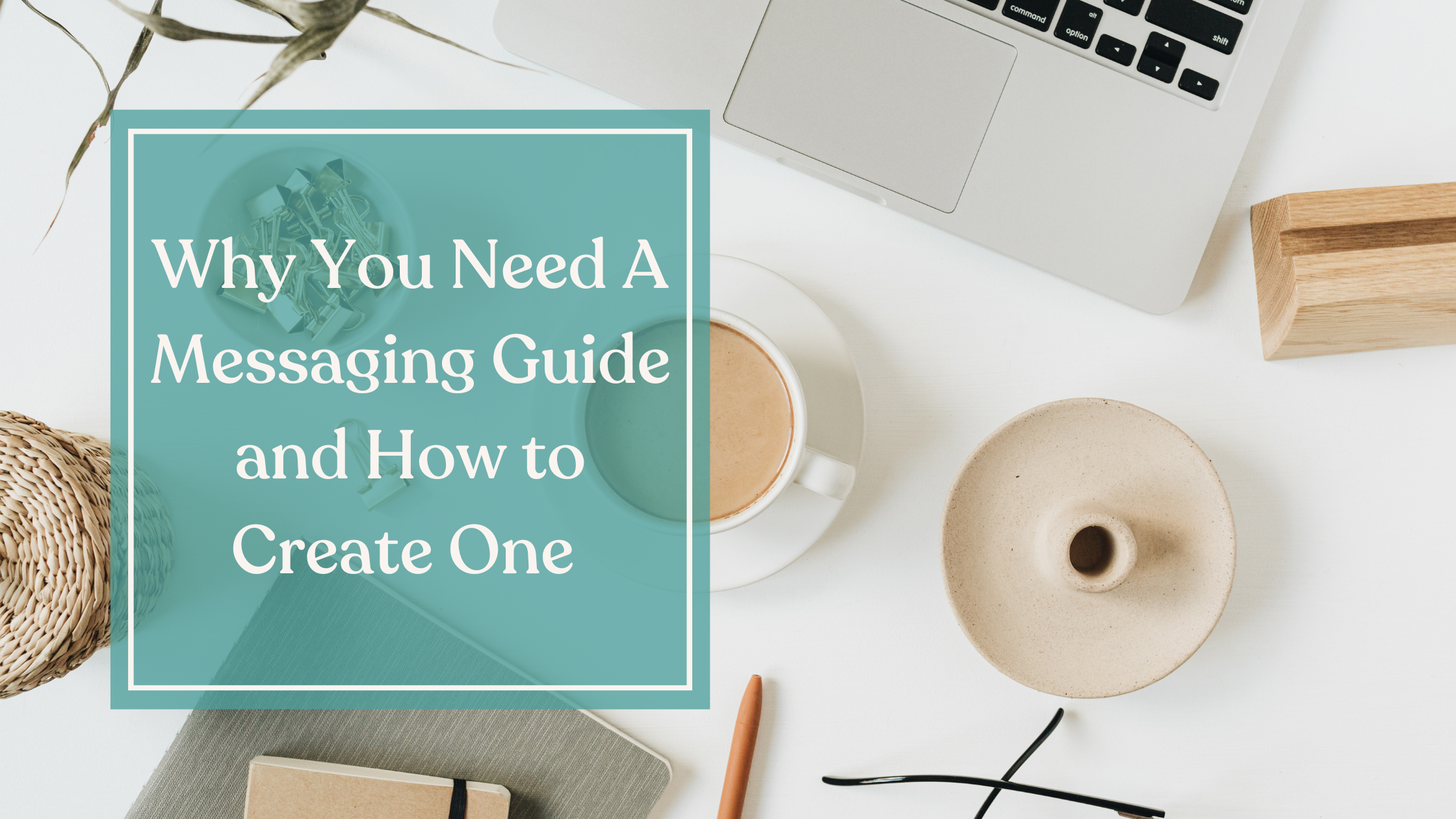I won’t write for clients without a messaging guide. Before you click away from this post, I promise we’ll get into why you need a messaging guide and how to create one. But first, I want to explain why a messaging guide is more than just a buzzword
If you want a copywriter to be able to efficiently get down to the core of your brand, and create copy that fits in with the rest of your marketing suite, you’re probably going to need a messaging guide. In the long run, a really solid messaging guide can save you so much money and so much time because it provides such a good framework for work to get started working with a copywriter.
But what even IS a messaging guide? Let’s dive in:
What Is A Messaging Guide?
A messaging guide provides context and explains what a company does, what sets them apart in the form of mission, vision, values, value proposition, and a positioning statement. If they’re understood well enough by the representative from the company that you’re working with, whether that’s you as a service provider, or a marketing person in a larger company, the messaging guide is going to come together, and it’s going to be amazing.
I am going to walk you through each portion of a messaging guide (what I include in a messaging guide, anyway) so you can fill in the blanks and create your own fantastic messaging guide. I’ve actually got a template you can follow as you read along.
Company Name & Tagline
In this first part of your messaging guide, you’ll simply start out with the name or your company or brand and the tagline (plus the sub brand name and sub tagline if applicable).
For example, my brand name is just “Haley,” and our tagline is “marketing that feels good for people who do good.”
The purpose of having this at the forefront of your messaging guide is to have it as a reference for anyone you bring on to do any kind of writing for your company.
Any sub brands or sub tab lines could include a signature product you have and that product tagline. I could do this with Haley as the company and brand and Propegy as the sub brand. If we had a tagline for Propegy, that would be how that ties together. T
This is really just to set the tone and have it be super clear from the jump whose messaging guide this is and what the most important things to know about the brand are.
Mission Statement
The mission statement is something that a lot of clients come to me really struggling with. It’s mostly because a lot of the formatting, conventions and recommendations that we get for mission statements kind of suck.
In our guide we use the structure
“to (verb) (target audience) to (goal of company.)”
You’ll fill in how you plan to help your target audience achieve the goal that your company sets out to help people achieve. For me, it’s “helping values driven service providers create marketing that feels good.”
This is how your messaging guide is actually going to start serving you as a messaging guide. If you’re working on your mission statement, and you come up with a really awesome sound bite or piece of language, and you don’t have a tagline, you can pull that up and use it in your tagline! You can then restructure your mission statements so they don’t sound identical, or you can use them as being very similar.
Remember: you don’t have to use every piece of your messaging guide together all the time. It’s meant to be an internal document that will help you drive public content. Just continue to check back in and assess if you’re connecting all the dots you’d like to be connecting with your messaging guide.
Company Vision
There are so many different ways to create a company vision that I usually just stick with the prompt “what would the world look like if you achieve your mission?” If you
you are able to accomplish what you want to accomplish with your company mission, what does that look like for the world?
This doesn’t need to be super specific. Some of the most revered companies have super simple vision statements. Nike is a super common company that people just refer to for marketing examples, because everyone knows the tagline “just do it.”The Nike vision statement, for example, is “we see a world where everybody is an athlete united in the joy of movement.” It’s very simple in the overall goal, but it’s still very clear that it’s related to Nike.
A better example of connecting a mission statement to a vision statement is actually going to be with LinkedIn. The LinkedIn mission is “connect the world’s professionals to make them more productive and successful.” That very much aligns with the structure that we have in our template. If you get into the LinkedIn company vision, it is “to create economic opportunity for every member of the global workforce.” Beyond the mission of finding connection, building productivity and success, we have the bigger picture of that as well.
What is the impact of your mission? THAT is the vision of your company.
Values
Next, we get into my favorite part of these messaging guides, which is values. We talk about values a lot when we have people starting companies for the first time, especially when we are looking at marketing. But, in the business profession, I don’t think we do a really good job of doing something with our values. In these messaging guides, we have a section for values and leave space for up to five values. You can have more than that, you can have less than that, I usually try to stick with three to five.
We break down values by the word itself, the definition, and then the company meaning. I started doing this breakdown with the definition and the company meaning about a year ago, when I realized that clients may use a different definition of a word than you’d think. Now, we include the definition and are able to be super clear with what we mean by that word.
The company meaning is how that word helps drive our interactions with our team members or interactions with our clients or interactions with our marketing or interactions with the world.
Example
Take the value of honesty, for example. If you look up the definition of honesty, it is “the quality of being honest, which isn’t super helpful.” But if you look at the definition of honest, it is “free of deceit and untruthfulness; sincere.” Sincerity is a really important part of how I want to run my business, how I want to do my marketing, and how I want to engage with my clients. Free of deceit and untruthfulness is a really good match for them. Under honesty in my values, I have the definition “free of deceit and untruthfulness; sincere.”
If you take the time to then go through and spruce up your values and make it sound fancy, you can get some really awesome sound bites out of that to use throughout the rest of your marketing. Multiply that by five and you’ve got a lot of little bits and pieces of really amazing copy to pull from when planning out other areas of your marketing.
Value Proposition & Positioning Statement
Value Proposition
Following our values, we have your value proposition and positioning statement, which are two “fill in the blank” parts of this messaging guide.
This is a place where you can really jam in a lot of the technical reasons why you do what you do, or how you do what you do and how it supports the people you work for. It can be a great place to put in all of the nuts and bolts that maybe you wanted to put into your mission statement. Then, bits and pieces of that statement can help to inform your other copy elsewhere.
Positioning Statement
Similarly, the positioning statement shows how your company does what it does better than other companies in a few different ways without saying it outright.
This is going to be something that might not sound good, you might not want to put it everywhere, but it’s going to really boil down the essence of who you are and what you do.
Brand Voice
Finally, we get down to what I think a lot of people think of when they think of the messaging guide, and that is going to be the brand’s voice. I personally think once you have the other stuff done well, you can kind of skip the brand voice. It should be pretty clear in your explanation of your mission, vision, and values what the voice and tone of your brand are.
If you need to clarify something specific that maybe doesn’t come off well in those other areas, this can be a great place to do it. I like to keep it super simple, just one word for voice and one word for tone.
The general explanation for brand voice versus brand tone is your brand voice is what you say and your tone is how you say it. What this can really come down to is the difference between the words that you use and the style of words that you use.
If you are an academic, and you’re targeting high-level thinkers, your brand voice is going to be more along the lines of like trustworthy, confident, intelligent, or academic. Your tone is going to be more about how you intelligently deliver what you’re saying.
Voice and tone can help shape the rest of your content. But so can examples of content that you do and don’t like for your brand. Speaking of content, the final part of the brand voice guide is key terms and phrases. If you have any taglines, in addition to your main tagline, that are used in certain situations, you can include this here.
You can give a little bit of explanation of different use cases, formatting, or conventions. If you are in an industry that is really particular or regulated, this can be a great place to get very specific about what can or cannot be included in your content or messaging.
Are you ready to dive into writing your own messaging guide? Click here to get access to my messaging guide template! If you’re like “no way, I will not be doing that myself” feel free to schedule a vibe check with me to see if I’d be the right person to help you with that messaging guide!




